A Famous Torpedo-Bomber Buscaglia's 281-5 Part II
A Famous Torpedo-Bomber Buscaglia's 281-5 Part II
Today Stefano Lazzaro presents Part II of his very interesting article entitled A Famous Torpedo-Bomber S.79 Carlo Emanuele Buscaglia's “281-5”:
A Famous Torpedo-Bomber S.79 Carlo Emanuele Buscaglia's “281-5" - Part II
A Famous Torpedo-Bomber S.79 Carlo Emanuele Buscaglia's “281-5" - Part II
Grazzie Mille
Ciao Stefano. This second part is at least as, if not more fascinating than the first. It is a true treasureto have people like you on Stormo. many thanks "Dottore", ciao, jean.
-
Stefano
- Generale di Brigata Aerea

- Posts: 170
- Joined: Sun Nov 12, 2006 2:40 pm
- Location: Padua, Italy
Thank you Jean and all other friends for your appreciation, I hope that these notes are useful for anybody who wants to make a model of this aircraft, and to know its history as well.
Of course, my research go on and I have some corrections to made since I sent my work to Vince:
- About the camo modifications, some colour photo suggest that 281-2 MM 23876 could have been repainted grigio azzurro overall.
- Four aircraft had additional fuel tanks, surely MMs 23959 and 23960, and probably 23838 and 23876. The equipment took down to save weight were: vertical camera and its support, bomb releasing device, bomb aiming device, bomb aimer instrument panel, tool box, oxygen inhalation plant (not surprisingly, remember that torpedo bombers flew at very low height).
- The cruiser attacked on 13 October was esteemed to be a HMS Leander-class (I found both Leaders and Leander names in the literature and I'm not a Royal Navy expert; the first was probably a mistake).
- The aircraft with old type exhaust was most probably MM 23885, so the MM list should be correct in this way:
MM 24089: 281-9 (hypothetical, not confirmed by photos, alternative to MM 23882) Arrived on 19 November; shot down on 28 December
MM 23885: 281-1 (almost sure, possibly it replaced MM 23877) Arrived on 19 November
By consequence, the note is to be delete.
Currently, I'm working on the two types of torpedoes used by RA: the Whitehead and the Silurificio Italiano. There are some differences that could be interesting by a modeller's point of wiew.
Stefano
Of course, my research go on and I have some corrections to made since I sent my work to Vince:
- About the camo modifications, some colour photo suggest that 281-2 MM 23876 could have been repainted grigio azzurro overall.
- Four aircraft had additional fuel tanks, surely MMs 23959 and 23960, and probably 23838 and 23876. The equipment took down to save weight were: vertical camera and its support, bomb releasing device, bomb aiming device, bomb aimer instrument panel, tool box, oxygen inhalation plant (not surprisingly, remember that torpedo bombers flew at very low height).
- The cruiser attacked on 13 October was esteemed to be a HMS Leander-class (I found both Leaders and Leander names in the literature and I'm not a Royal Navy expert; the first was probably a mistake).
- The aircraft with old type exhaust was most probably MM 23885, so the MM list should be correct in this way:
MM 24089: 281-9 (hypothetical, not confirmed by photos, alternative to MM 23882) Arrived on 19 November; shot down on 28 December
MM 23885: 281-1 (almost sure, possibly it replaced MM 23877) Arrived on 19 November
By consequence, the note is to be delete.
Currently, I'm working on the two types of torpedoes used by RA: the Whitehead and the Silurificio Italiano. There are some differences that could be interesting by a modeller's point of wiew.
Stefano
-
Stefano
- Generale di Brigata Aerea

- Posts: 170
- Joined: Sun Nov 12, 2006 2:40 pm
- Location: Padua, Italy
281-2 MM 23876 was a SIAI-built aircraft which wore the standard mottle camo, as you can see in this photo showing Ten. Cimicchi and his crew beside it, at Grottaglie before their departure to Rhodes.
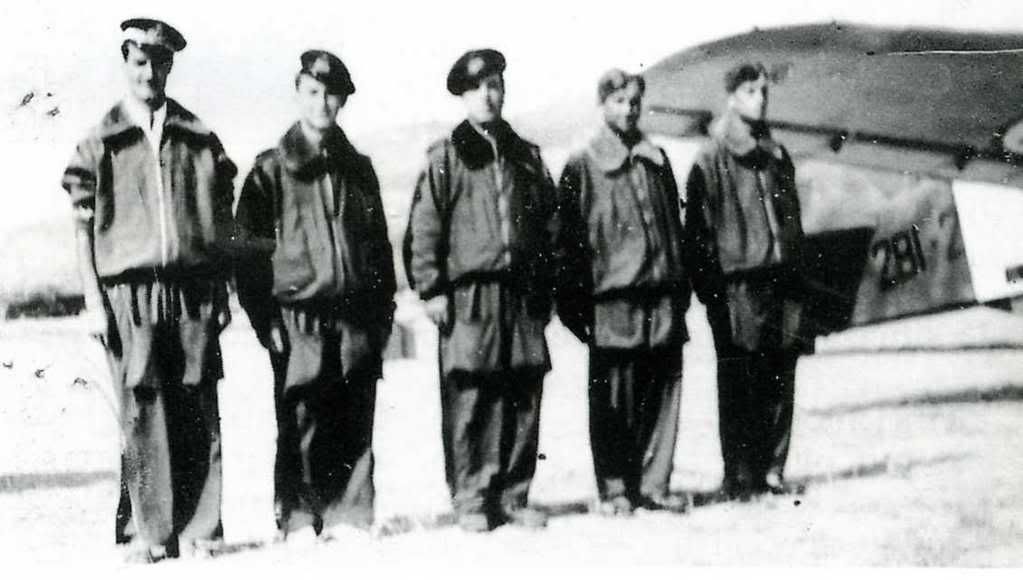
Note that the leading edge had still the mottle camo. This aircraft received the grey on front side at Rhodes. Of course, no codes overpainted, in that this aircraft was never assigned to other units before. Front-firing machine gun was lacking on these aircraft, and was added later. Considerations for the camo are the same of those for 281-5 (they belonged to two nearby SIAI production batches). Later in the war, on 281^ Squadriglia's aircraft were experimented some new camos, details of whose are unknown, but some images suggest that at least 281-2 was painted grey on uppersides. Note in the following image that on this aircraft (individual no. is on the nose) the white band was still kept, but aft it the camo is no longer mottled. The undersides seem now grey, as the background of wing fasci. Note also that the front side of propeller blades is not black as in the kit box cover.
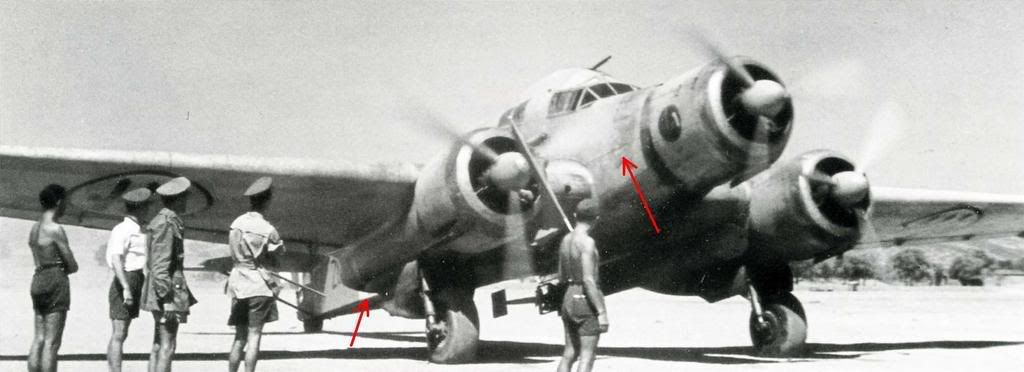
In a colour photo took in the same action we can see, notwithstanding its bad quality, that the upperside colour was quite the same grey than frontside, whose aft edge in earlier camo scheme never passed the windows below the hunchback.
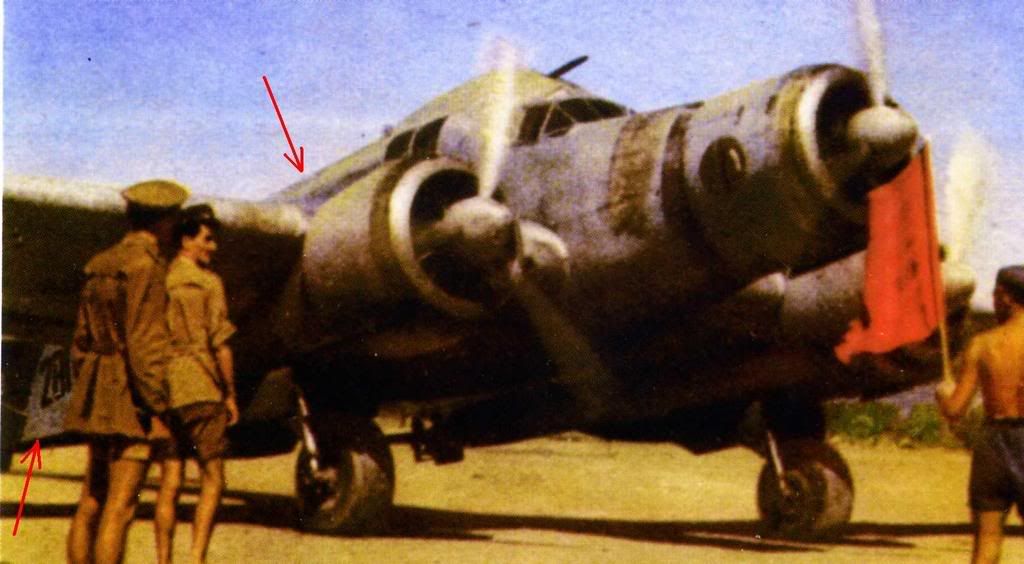
Lacking photo evidence, I can't say if 281-2 was later painted with the "sea waves" scheme.
I hope this helps.
Have a good work.
Stefano

Note that the leading edge had still the mottle camo. This aircraft received the grey on front side at Rhodes. Of course, no codes overpainted, in that this aircraft was never assigned to other units before. Front-firing machine gun was lacking on these aircraft, and was added later. Considerations for the camo are the same of those for 281-5 (they belonged to two nearby SIAI production batches). Later in the war, on 281^ Squadriglia's aircraft were experimented some new camos, details of whose are unknown, but some images suggest that at least 281-2 was painted grey on uppersides. Note in the following image that on this aircraft (individual no. is on the nose) the white band was still kept, but aft it the camo is no longer mottled. The undersides seem now grey, as the background of wing fasci. Note also that the front side of propeller blades is not black as in the kit box cover.

In a colour photo took in the same action we can see, notwithstanding its bad quality, that the upperside colour was quite the same grey than frontside, whose aft edge in earlier camo scheme never passed the windows below the hunchback.

Lacking photo evidence, I can't say if 281-2 was later painted with the "sea waves" scheme.
I hope this helps.
Have a good work.
Stefano
-
Stefano
- Generale di Brigata Aerea

- Posts: 170
- Joined: Sun Nov 12, 2006 2:40 pm
- Location: Padua, Italy
Here is another image where the individual no. is better visible. It is partially covered by a large fuel spot.
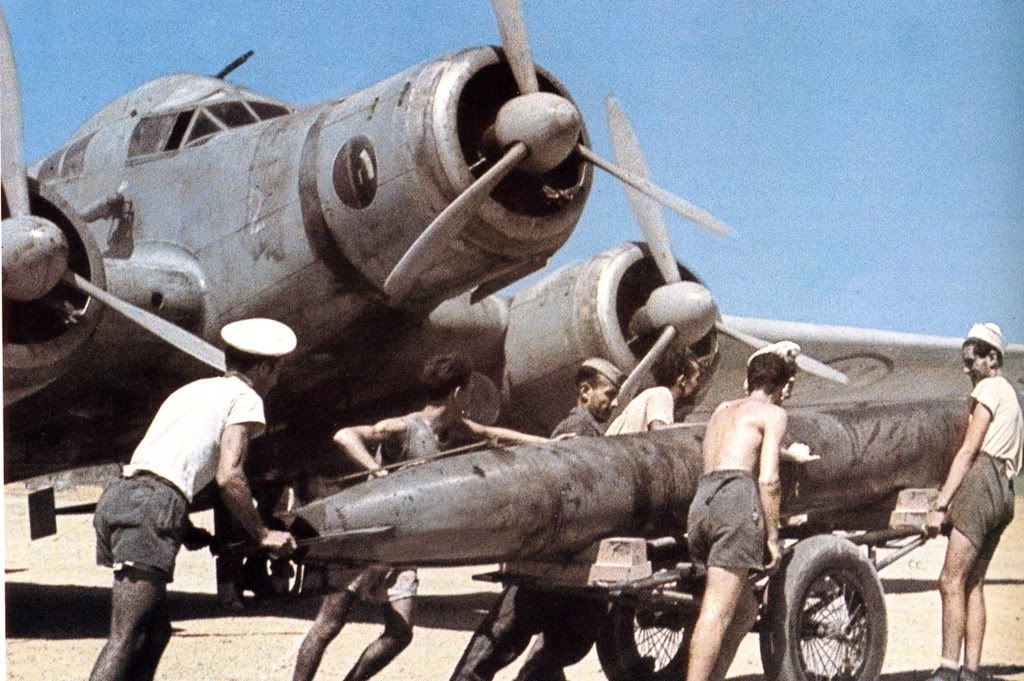
In this image the spinners and propellers seem to be grey, but the colour quality is poor. Usually they were light blue FS 35226, as told, but SIAI official colour indications of 21 February 1940 stated the use of Arson 53518 Grey (probably very similar to Grigio Azzurro Chiaro 1) for propellers. So judge the images and make your choice: whatever it is, it will be historically correct. The engine covers were however overpainted grey.
Stefano

In this image the spinners and propellers seem to be grey, but the colour quality is poor. Usually they were light blue FS 35226, as told, but SIAI official colour indications of 21 February 1940 stated the use of Arson 53518 Grey (probably very similar to Grigio Azzurro Chiaro 1) for propellers. So judge the images and make your choice: whatever it is, it will be historically correct. The engine covers were however overpainted grey.
Stefano
-
Stefano
- Generale di Brigata Aerea

- Posts: 170
- Joined: Sun Nov 12, 2006 2:40 pm
- Location: Padua, Italy
The engine rings were three: aluminium the front one and the rear, heat-resisting cast iron in the middle (it was an exhaust collector) as the exhaust tube and the rectangular plate where the latter was laid. The aft ring was often covered by paint during overpainting, as was for 281^ Squadriglia's aircraft, but, due to the lacking of primer and the heat, here the paint frequently chipped away.
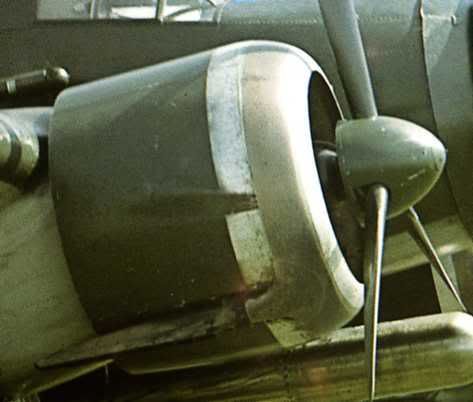
Being a SIAI-built aircraft, 281-2 was most probably painted Verde Mim 53192 and Marrone Mim 53193 over Giallo Mim 3. Analysis of original factory wood models, in facts, confirms that these colours were used on mottle-camouflaged S.79s, while the band-camo ones had Verde Mim 1, Marrone Mim 2 and Giallo mim 3. The colours you mean were used by Caproni, where 281-5 was overhauled, so I hypothized that they could have been applied on it, but this is unlikely for 281-2.
Ciao,
Stefano

Being a SIAI-built aircraft, 281-2 was most probably painted Verde Mim 53192 and Marrone Mim 53193 over Giallo Mim 3. Analysis of original factory wood models, in facts, confirms that these colours were used on mottle-camouflaged S.79s, while the band-camo ones had Verde Mim 1, Marrone Mim 2 and Giallo mim 3. The colours you mean were used by Caproni, where 281-5 was overhauled, so I hypothized that they could have been applied on it, but this is unlikely for 281-2.
Ciao,
Stefano
-
Stefano
- Generale di Brigata Aerea

- Posts: 170
- Joined: Sun Nov 12, 2006 2:40 pm
- Location: Padua, Italy
In my opinion, the conical ring was still camouflaged, as was for 281-5 in its early finish. You can see it also in image no. 13 (281-2 should be third from right). This leads to believe that the grey was "extended" to all uppersurfaces, and the aircraft was not overpainted in its old grey areas.
If you want to make this aircraft in the all-grey livery as in the photos, please note that the torpedo is a Silurificio Italiano-built, and has some differences with the classic Whitehead you find in the kits. I'm doing a research on them and I hope Vince will publish it in this site.
Have a good work.
Stefano
If you want to make this aircraft in the all-grey livery as in the photos, please note that the torpedo is a Silurificio Italiano-built, and has some differences with the classic Whitehead you find in the kits. I'm doing a research on them and I hope Vince will publish it in this site.
Have a good work.
Stefano


